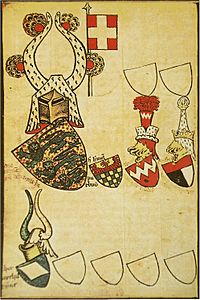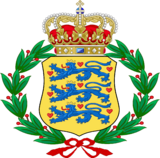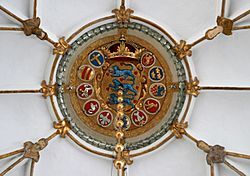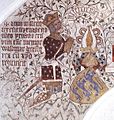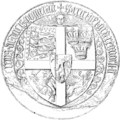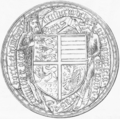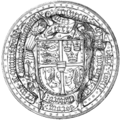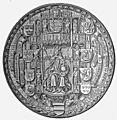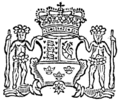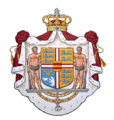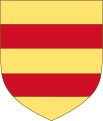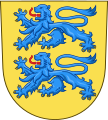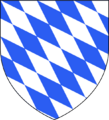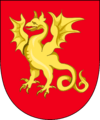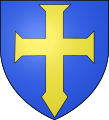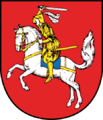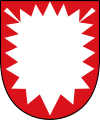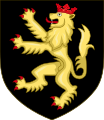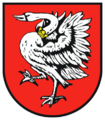Coat of arms of Denmark facts for kids
Quick facts for kids Greater coat of arms ofDenmark |
|
|---|---|
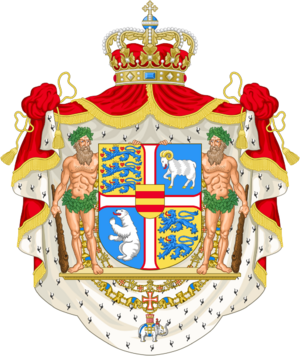
Greater (royal) version
|
|
| Versions | |
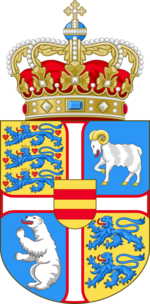
Middle version
|
|
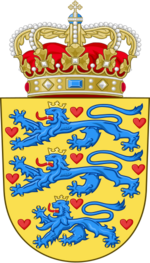
Lesser (state) version
|
|
| Armiger | Frederik X, King of the Danish Realm (greater version) Government of Denmark (lesser (state) version) |
| Adopted | First documented in the 1190s. Designated as dynastic arms 1959. Last modified 20 December 2024. |
| Crest | Crown of King Christian V |
| Torse | tasseled strings Or |
| Blazon | A shield quartered by a cross pattée argent bordured gules, first quarter Or, three lions passant in pale azure crowned and armed Or langued gules, nine lily pads gules (for Denmark); second quarter azure, a ram passant argent armed and unguled Or (for the Faroe Islands); third quarter azure, a polar bear rampant argent (for Greenland); fourth quarter Or, two lions passant in pale azure armed Or langued gules (for Schleswig). Overall an escutcheon Or two bars gules (for Oldenburg) |
| Supporters | two wild men armed with clubs Proper |
| Compartment | pedestal |
| Motto | Latin: Magnanimi Pretium |
| Order(s) | Order of the Dannebrog, and Order of the Elephant |
| Other elements | The monarch places this coat of arms on a mantle gules lined with Ermine. Above the mantle is a pavilion gules again topped with the royal crown. |
The coat of arms of the Danish Realm (Danish: Danmarks rigsvåben) is a special symbol for Denmark. It comes in two main types: a smaller one and a larger one.
The smaller coat of arms, used by the Danish government, shows three blue lions wearing crowns. They are walking across a golden shield. Around them are nine red shapes that look like lily pads or hearts. A royal crown sits on top of the shield.
The national coat of arms of Denmark (nationalvåben), also called the "little arms" (lille våben), is very similar to the state coat of arms. The main difference is that it does not have the royal crown above the shield.
This symbol comes from the House of Estridsen, a royal family that ruled Denmark a long time ago, from 1047 to 1412. For many years, there was no real difference between the "national" and "royal" coats of arms. But since 1819, Denmark has had a more detailed royal coat of arms (kongevåben) that is separate from the national one. The newest design was introduced in 2024 by Frederik X, the current King.
Contents
History of the Danish Coat of Arms
The oldest known picture of this symbol is from a seal used by King Canute VI around 1194. We know what colors were used from around 1270.
In the past, the lions faced forward, and there could be many more than nine "hearts." These "heart" shapes were actually meant to be waterlily pads. A royal rule from 1972 still calls them søblade, meaning "lake leaves."
The current design was set in 1819 by King Frederick VI. He decided there would always be nine hearts and that the animals were lions, facing forward.
Around 1960, Denmark stopped using both a "small" and a "large" coat of arms for official government use. The larger one became known as the coat of arms for the royal family. This means Denmark now has one main national coat of arms for all official purposes.
The crown on the shield is a special design based on the crown of King Christian V. It is not the same as the crown of King Christian IV. The real crowns and other royal items are kept at Rosenborg Castle in Copenhagen.
The Danish coat of arms is very similar to the coat of arms of Estonia and the greater coat of arms of Tallinn. This is because of King Valdemar II and Danish rule in northern Estonia from 1219 to 1346.
The newest royal coat of arms was officially adopted on December 20, 2024.
Royal Coat of Arms
The royal coat of arms is more detailed than the national one. The current design was put in place by a royal rule on December 20, 2024. It is simpler than older versions.
The shield is divided into four parts by a silver cross with a red border. This cross is like the Danish flag.
- The first part shows Denmark with three crowned lions and nine hearts.
- The second part shows the Faroe Islands with a silver ram on a blue background.
- The third part shows Greenland with a silver polar bear on a blue background.
- The fourth part has two lions, representing Southern Jutland, which was once part of Schleswig.
In the very center of the shield is a smaller shield with two red bars on a golden background. This represents the House of Oldenburg, the royal family that ruled Denmark and Norway for a long time. Even though a different branch of the family, Glücksburg, took over in 1863, they still use the Oldenburg symbol.
Two "woodwoses" (vildmænd), which are like wild men, hold up the shield. This tradition goes back to the early days of the Oldenburg family. Around the shield are symbols of two important Danish awards: the Order of the Dannebrog and the Order of the Elephant.
The shield and its supporters are surrounded by a royal ermine (white fur with black spots) robe. A royal crown sits on top of this robe.
Since about 1960, the royal coat of arms has been used only by the monarch, the royal family, the Royal Guards, and the royal court. Some businesses that supply the royal family are also allowed to use this symbol.
Changes to the Royal Arms in 2024
On December 20, 2024, King Frederik X updated the royal coat of arms. His mother had last changed it in 1972. In the new design, Greenland and the Faroe Islands have been given more space. They now each have their own section in the four main parts of the shield.
This change shows the King's wish for a modern royal coat of arms that represents the whole Danish Realm while still respecting history. Before, the Faroe Islands and Greenland shared one section. The Schleswig lions, representing South Jutland, still have their own section. These two lions are a special reminder of South Jutland's history and have been used since the mid-1200s.
Along with the new coat of arms, the Royal House also updated the royal flags. The new royal coat of arms is now on several flags flown by the Royal House. The Royal Flag has the new coat of arms in the middle. The Queen's flag has both the Queen's coat of arms and the King's new coat of arms. Crown Prince Christian also has a new flag with the royal coat of arms in the middle, topped with the Crown Prince's Crown. These new royal flags have been flown at Amalienborg since January 1, 2025.
The three crowns, which had been part of the royal arms for 500 years and symbolized the Kalmar Union (a union between Denmark, Norway, and Sweden from 1397 to 1523), were removed in the 2024 update.
Artwork for the New Arms
Ronny Skov Andersen, a royal coat of arms painter, designed and drew the new royal coat of arms. He also led a committee that was formed shortly after King Frederik X became king on January 14, 2024. This committee made sure the King would have a new coat of arms.
Different Versions and Uses
Government Use
Different versions of the Danish Royal Arms are used by the Kingdom's government, including the Government, the Parliament, and the courts. The government and its agencies usually use a simpler version of the Royal Arms. This version does not have the large robe, the pavilion, or the royal crown on top. This simpler Royal Arms also appears on passports and at Danish embassies and consulates around the world.
Other Royal Family Members
Members of the royal family also have their own coats of arms, which are based on the main royal arms but have special additions.
| Coat of arms | Bearer | Description |
|---|---|---|
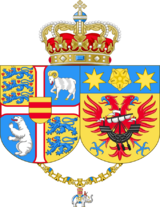 |
Queen Mary | Queen Mary's coat of arms combines her husband's shield with her own, which she received in 2004. Her shield is gold and features a red MacDonald eagle and a black boat, showing her Scottish background. The top blue part has two gold Commonwealth Stars from Australia and a gold rose, which is her personal symbol. A Royal Crown of Denmark sits on top. |
 |
Crown Prince Christian | Crown Prince Christian's coat of arms is like the royal coat of arms, but it has the crown of the heir to the throne and a purple robe. |
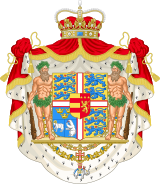 |
Prince Joachim | Prince Joachim's coat of arms is similar to the 1972-2024 royal coat of arms. His central shield is divided, showing symbols for the House of Oldenburg and the House of de Laborde de Monpezat. It is topped with the crown of a Prince of Denmark. |
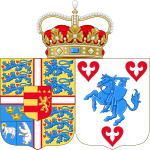 |
Princess Marie | Princess Marie's coat of arms combines her husband's shield with her own, given to her in 2010. It shows a horseman in blue, representing her maiden name Cavallier (meaning knight or horseman). It also has a mix of Danish and French symbols: three red hearts for Denmark and a fleur de lys for France. |
Images for kids
-
A medieval ship flag captured by forces from Lübeck in the 1420s. It shows the arms of Denmark, Sweden, Norway, and Pomerania.
-
The earliest known example of the Danish coat of arms, from the seal of Canute VI, 1190s.
Gallery of Historical Arms
-
Seal of Valdemar II the Victorious (1202–41)
-
Seal of Eric VI Menved (1286–1319). The two eagles refer to his mother, Agnes of Brandenburg.
-
Seal of Valdemar IV Atterdag (1340–75), early 1340s
-
One of the seals of Eric VII "of Pomerania", 1398. The three Danish lions carry a Danish flag.
-
Seal of Christopher III "of Bavaria", 1440s
-
Secret seal of Christian I, 1449
-
Secret seal of Christian I, 1457–60
-
Seal of King Hans (1481–1513)
-
Seal of Christian III (1534–59)
-
Coat of arms of Christian III from the first Danish-language Bible, 1550
-
Coat of arms of Frederick II. Engraving by Jens Bircherod, 1581
-
Eric XIV of Sweden added Norwegian and Danish arms to the Swedish coat of arms. This led to the Northern Seven Years' War.
-
Coat of arms of Frederick II, 1592 engraving
Elements Currently Used in the Arms
Elements Formerly Used in the Arms
-
King of the Goths/Jutland
-
The Swedish royal House of Bjälbo, seen as the arms of Götaland in the 17th century
-
Iceland (older symbol)
-
King of the Wends/Funen
Related Symbols
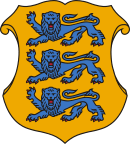
Many other symbols are similar to or inspired by the Danish coat of arms:
- The coat of arms of Estonia and its capital, Tallinn.
- The coat of arms of Schleswig (also seen in Denmark's royal family arms).
- The coats of arms of towns like Ribe, Varde, Halmstad, and Ystad.
- The coat of arms of the former South Jutland County.
- The coat of arms of the former North Jutland County.
- The coat of arms of the German area of Lüneburg.
- The coat of arms of Schleswig-Holstein.
- The coats of arms of the German town of Dannenberg.
- The coat of arms of the Estonian Knighthood.
- The personal arms of Prince Philip, Duke of Edinburgh included parts of the Danish arms. This was because he was a descendant of the Schleswig-Holstein-Sonderburg-Glücksburg branch of the Danish House of Oldenburg.
- The Danish lion and hearts are also featured in the Order of Saints George and Constantine and the Order of Saints Olga and Sophia, which are awards given by the Greek royal family.
See also
 In Spanish: Escudo de Dinamarca para niños
In Spanish: Escudo de Dinamarca para niños
- Coat of arms of Greenland
- Coat of arms of the Faroe Islands
- Danish heraldry
- Royal Arms of England
- Flag of Denmark
- Coat of arms of Estonia
- Lion (heraldry)



